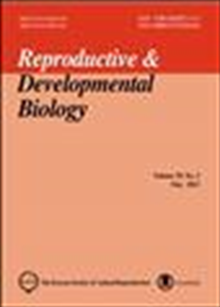간행물
Reproductive & developmental biology

- 발행기관 한국동물번식학회
- 자료유형 학술지
- 간기 계간
- ISSN 1738-2432 (Print)2288-0151 (Online)
- 수록기간 1977 ~ 2018
- 주제분류 농수해양 > 축산학 농수해양 분류의 다른 간행물
- 십진분류KDC 527DDC 636
권호리스트/논문검색
Volume 40 No 2 (2016년 6월) 2건
1.
2016.06
구독 인증기관 무료, 개인회원 유료
Yong Hwangbo, Hwa-Young Kim, Yu-Rim Lee, Seung Tae Lee, EunSong Lee, Hee-Tae Cheong, Boo-Keun Yang, Choon-Keun Park
As a one of unsaturated fatty acid, polyunsaturated fatty acids (PUFAs) have multiple actions: as precursor of prostaglandins (PGs), steroid hormone synthesis and energy production in animal reproduction. PUFAs, which include omega-3 (n-3) and omega-6 (n-6), are derived from the diet and changed by diet, species, breed and season. The plasma membrane of spermatozoa in mammals contain various PUFAs. These composition of PUFAs regulate the membrane fluidity and cause lipid peroxidation via generation of reactive oxygen species (ROS). Induced lipid peroxidation by ROS decreased viability and motility of spermatozoa, and it is reduced by addition of antioxidant and low concentration of PUFAs. Because oocytes of animal have a high lipid components, process of oocyte maturation and embryo development are influenced by PUFAs. In in vitro study, oocyte maturation, embryo development, intracellular cAMP and MAPK activity were increased by treatment of n-3 α-linolenic acid (ALA) during maturation, whereas n-6 linoleic acid (LA) negatively influenced. Also, inhibition of fatty acid metabolism in oocyte influenced blastocyst formation of cattle. PGs are synthesized from PUFAs and various PUFAs influence PGs via regulation of PG-endoperoxide synthase (PTGS). Steroid hormone synthesis from cholesterol is regulated by expression of steroid acute regulator (StAR) protein and mRNA. Exogenous n-3 and n-6 PUFAs altered sex hormone in animal through stimulate or inhibit StAR activity. Because PUFAs altered PG and steroid hormone synthesis, follicular development was influenced by PUFAs. This effect of unsaturated fatty acid could provide information for improvement of reproductive ability in animals.
4,000원
2.
2016.06
구독 인증기관 무료, 개인회원 유료
Transcription factor called activating enhancer binding protein 2C (AP2-gamma) is found in a variety of species and expressed from oocyte stage onwards, particularly restricted to the trophectoderm. Recent studies demonstrated that ablation of Tfap2c led to failure of tight junction biogenesis, particularly the knock-down embryos of Tfap2c did not form cavity from morula to blastocyst in mouse and pig. We speculated that the Tfa2pc may also be involved in desmosome biogenesis because blastocoel formation is coincident with the establishment of desmosome. To determine this, we depleted Tfap2c injecting siRNA into one-cell zygote and analysed the expression levels of genes that are required for desmosome complex such as PkP2, Pkp3, Dsc2, and Dsg2. We found only Pkp3 was up-regulated in the knockdowned morula embryos. Interestingly, upstream region of Pkp3 had putative Tfap2c binding sites. In conclusion, our results suggest that Tfap2c is not a crucial factor but somehow it might be involved in desmosome biogenesis directly or indirectly via Pkp3.
3,000원

